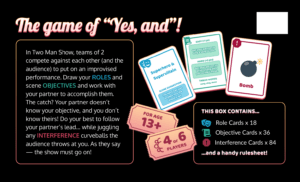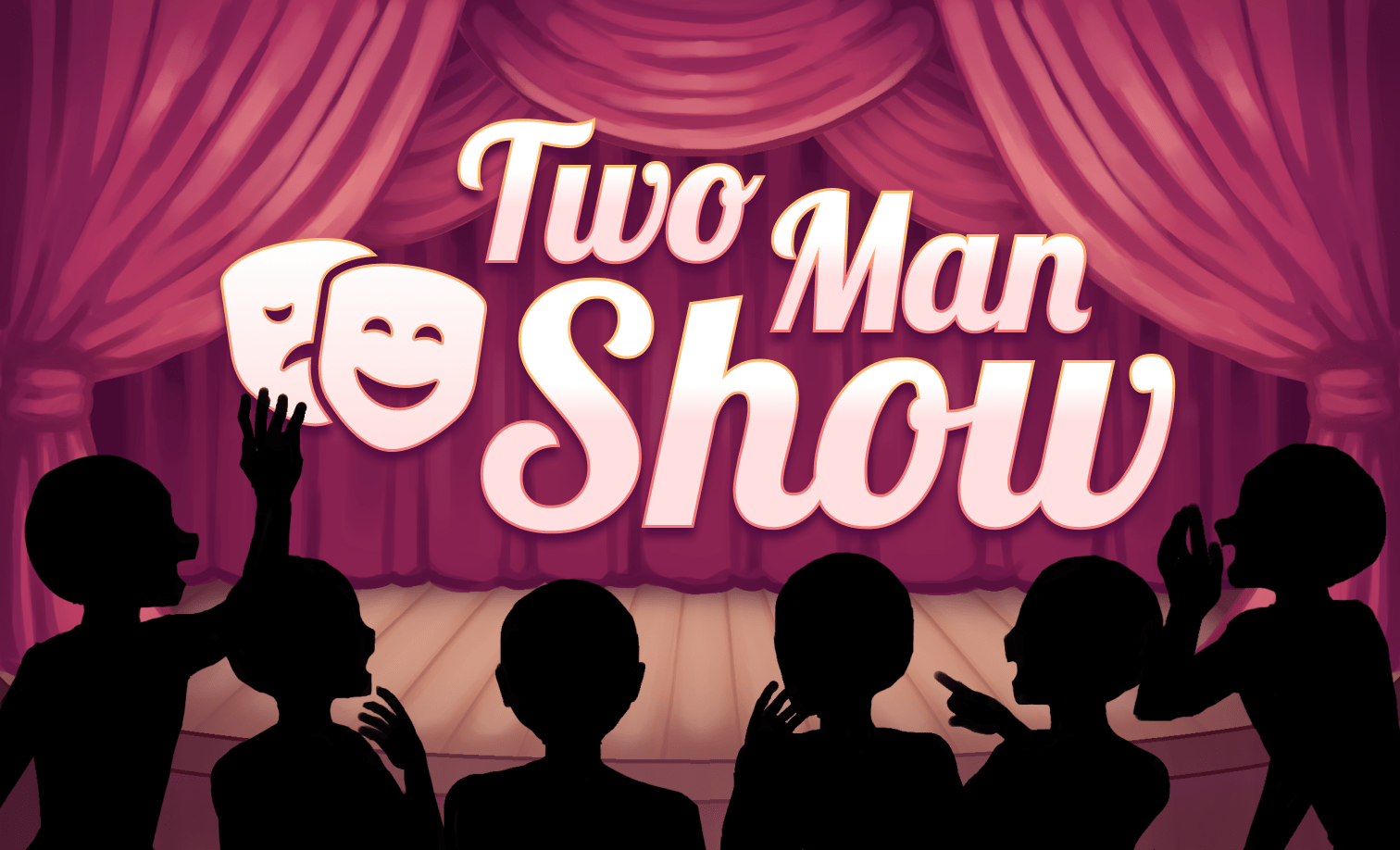Overview
P4 Team Members: Jasmine Steele, Ember Fu, and Miranda Diaz
Two Man Show is a fast-paced card-based party game intended to teach players the basic principles of improv — in particular, the golden rule of “Yes, and” (don’t shoot down your partner’s suggestions, expand on them!). Originally created for P1, our team decided to refine this game for P4 by expanding the deck, improving and polishing the visual design, and implementing some playtest suggestions that didn’t make it into P1’s final product.
The basic structure of Two Man Show is as follows: an even number of players divides into teams of 2. Each round, one team becomes the acting team and all other teams become the audience. The acting team draws one Role card dictating the pair of roles they will play in their scene; each actor also draws an Objective card which they read and show to the audience but keep hidden from their partner. Each audience member draws 3 Interference cards which they can play during the acting team’s scene. The actors then have 3 minutes to improvise a scene in which they embody their assigned roles and attempt to achieve their own objectives — without directly telling their partner what their objectives are. The acting team gets points for each objective they, collectively, complete. Meanwhile, the audience can attempt to sabotage them by playing Interference cards to introduce items and events to the scene which the actors must incorporate. Once each team has performed 3 times, the team with the most points wins!
We aimed to make the game fun for those with any amount of improv experience, allowing advanced players free creative reign if they wish to take it while also providing optional concrete prompts for less experienced players.
Intentions for Refinement
You can read about how we created Two Man Show and its original state here. We decided to both refine some game rules and mechanics as well as update our visual design. For gameplay, in general this meant fleshing out the game’s content by adding more cards and testing for replayability. We also wanted to try introducing a new card subtype, blank Interference cards, as players had previously alluded to potentially wanting to come up with their own objects.
Thus, an additional goal was testing this and adding specifications in our rules–such as extra improv guidelines, how to use Interference cards, etc. As to our visual design goals, we felt that the pastel design of our original theme didn’t quite fit with the theatrical atmosphere of Two Man Show. Thus, we wanted to update the game’s visuals entirely, including all cards and box art.

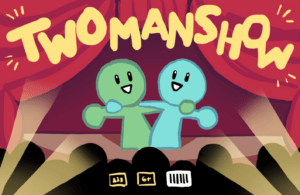
(Left: blank “fill-in” Interference card; Right: original box art draft for new thematic direction)
Playtesting
Playtest #1
We held our first playtest during class on 3/14/23 with Jihun, Lucy, Alejandro, and Nick. Alejandro was the only participant who had played a previous iteration of Two Man Show before. The goal of this playtest was to get a sense of how replayable the game was. We had made two changes to the game from its P1 version. Based on feedback that we received during one of our P1 playtests, we decided to add blank interference cards that would allow an audience member to add any item of their choice to the current scene. We hoped that these cards would help keep things fresh by capitalizing on the audience’s creativity. We also added a lot of new cards to the three decks: 12 role cards, 36 interference cards, and 24 objective cards.
Some of the key observations from the first playtest are as follows:
- Audience played a kazoo interference card and immediately used a blank interference card to play another kazoo
- Actors wanted a 30 second warning before the end of their scene
- One player wanted to replace their hand of interference cards in hopes of getting more violent ones
- Players generally preferred more silly or ridiculously specific items for interference cards
- One audience member would say how an item appeared into the scene when they played interference cards, rather than just announcing the object
- Actors would bring in random items that they needed for the scene, items that did not originate from interference cards
- One team of actors had consistent themes across their three performances of the game which everyone thought was very funny
- A lot of laughing and happy play noises throughout
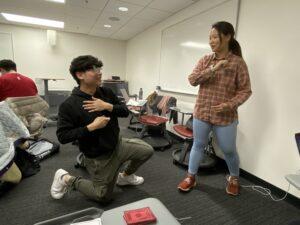

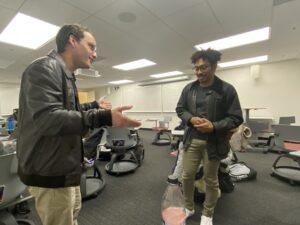
(Pictures from our first playtest with 4 players)
Based on these insights, we thought that the blank cards were a success. They allowed for unique and challenging scenarios (like the double kazoo example) that would have been impossible with the original deck of interference cards. Since our learning objective is to help people get more comfortable with improv and creative thinking on the spot, the blank cards help add a level of difficulty where it is more difficult for actors to predict how their scene will be derailed next. A future direction that we could explore would be allowing players to decide on the difficulty of their game by letting them choose if they want to play with blank cards in the interference deck.
We also decided to make it a rule that audience members should announce how an interference item is relevant to the scene without deciding how actors would ultimately react to the interference. For example, if an audience member wanted to play a pineapple interference card, they should say something like “The pineapple falls out of the sky and hits you on the head” rather than just “There is a pineapple” or “There is a pineapple, and you are going to stop what you’re doing to eat it.” The ideal introduction of the pineapple card removes some of the creative burden on the actors to incorporate a random pineapple into their scene. It gives them more time and energy to focus on deciding how they want to react and respond to the pineapple’s introduction without limiting any of the possible directions they can take. The focus on reaction and recovery felt more inline with our learning goals and how improv actually functions.
Final Playtest
We held our final playtest during class on 3/16/23 with Shimea, Marielle, Ada, and Ivan as our original group of players. After two rounds, Nick and Alejandro joined the game. Gilbert and Amy later joined to give the last performance of the playtest. Marielle, Ivan, Nick, and Alejandro had all played a previous iteration of Two Man Show. This version of the game included the changes mentioned in our first playtest as well as full box art and updated card designs.
Some of the key observations from the final playtest are as follows:
- Audience members were surprised to see the kind of loopholes that actors would come up with to incorporate the interference cards. Audience seemed to mimic these workarounds in their following performance
- Some audience members would spam interference cards back-to-back, making it difficult for actors to make progress
- Returning players said that the game had gotten much harder since the last time that they played
- Players stopped caring about the point count later in the game and just wanted to keep playing
- Players would eventually join and leave the game between rounds
- Multiple actors wanted the timer to pause when an interference card would be played
- Players were excited when they drew new role cards, often exclaiming “Oh, this will be fun!”
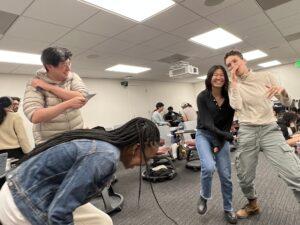
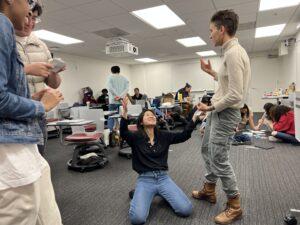
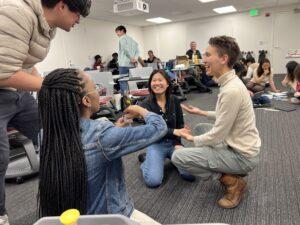
(Pictures of our final playtest, with 4, 6, and many more players!)
We were surprised to see that returning players thought that the game had become more difficult. We imagine that this difficulty came from the fact that this was the first time that we were playtesting with a full game of six players. To try to balance the game during the playtest, we decided to begin pausing the timer when an interference card was being played, so actors have more time to recover from the interference. We also decided to remove some of the blank interference cards from the deck. We felt that there were too many in the deck considering how powerful they are. Lastly, we decided to limit the number of interference cards that the audience could play to one per person. This would help prevent one person spamming while keeping the maximum cards played during a performance to four. In a four person game, this would change to two per person to again keep the maximum played to four. While we would like to have some difficulty in our game, we ultimately want the experience to be a positive one. We want players to struggle, but not feel overwhelmed/disadvantaged to the point where they want to give up. We can better achieve our learning goal by keeping people playing and practicing their improv skills along the way.
Overall, we were happy to see how much fun people had playing Two Man Show. We didn’t expect for players to swap in and out as much as they did. We certainly didn’t expect players to stop caring about their score all together. We think these were all positive signs because it shows that we were able to involve a larger audience in playing and practicing improv. The scoring is there to help player’s get feedback on their performances, and players would still check how many objectives they completed after each performance. Winning the game isn’t essential to our learning goal since improv is a learn-by-doing skill. Having players be so invested in simply putting on performances and reflecting after each performance via their objectives is enough to help them develop their creative thinking skills.
Visual Design

(Examples of each card type, back and front)
We had three main goals in our visual design for Two Man Show: simple card design for quick learning, bold colors and fonts to cultivate a high-energy atmosphere, and a masks-and-curtains motif throughout to invoke a theatrical mood.
To unify the design and make key information readable at a glance, the three card types (Role, Objective, and Interference) all have the same basic design: a brightly-colored back with a symbol in the center indicating card type, a white front outlined in the same bright color with the same symbol in the top left corner (for easy fanning), and the card content in the center of the front. Because Interference cards are meant to be played quickly and repeatedly throughout a round, each features a large graphic and a short item/event descriptor in large font, making it easy to process all information on the card at a glance. By contrast, Role and Objective cards are primarily read at the beginning of a round when players are expected to take a moment to process and strategize, so both of these card types display more information in a smaller font. This information is organized into labeled boxes to make it easy to digest.
The box (custom illustrated by Jasmine) was designed to firmly establish the theatrical theme from the moment a player lays eyes on it. The front shows a raucous audience in front of a Broadway-esque stage, priming players to expect a chaotic atmosphere and lots of audience interaction; the sides are draped with curtains to tie in with the front; and the back shows an example of each card type alongside the game pitch to give prospective players a clear idea of what to expect. The logo font was chosen to loosely invoke an old-timey theater marquee, and a mask graphic is included in the logo to further drive home the theatrical theme.
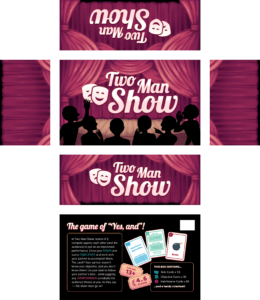
(Image of our printable box art)
Final Game
With all of our changes, we believe we achieved our goals in evolving Two Man Show into a still-hectic, but more streamlined, content-rich party game about improv. Our game offers the fun of Fellowship, Expression, Fantasy, and Challenge through the facilitation of improv, difficult objectives alongside limitations like not knowing your partner’s or avoiding Taboo words, and the variety of wacky roles and objects. The objective of the game is to earn the most points with a partner through acting, and obstruct other duos from doing so as part of the conflict. Two Man Show is designed for 4 or 6 players for ages 13+, though flexible enough for house rules!
Our final gameplay changes account for our refinement intentions as well as new learnings from our playtesting. For example, having audience players give context for how an Interference card comes into the scene was a great way to give some more power to the audience while also relieving some of the pressure on the actors. To account for this, we also added the rule of pausing the timer when Interference cards are played. We also found success with adding the new blank Interference cards in a limited number, as to not dominate the deck but also provide some player choice and extra fun.
In totality, our final game for Two Man Show includes:
- A 3-minute hourglass timer
- A rule sheet
- 138 total cards
- 84 Interference cards
- 72 objects, 12 blank
- 18 Paired Role cards
- 36 Objective cards
- 84 Interference cards
- Amazing box art! (Which you can print separately here)
You can read our updated rules here and access the new Print & Play here.
